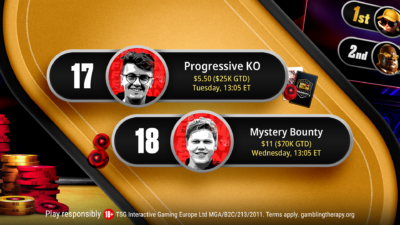Anyone who has reached the very top of their craft — be it sports, art, business or anything — must be used to being asked the same old questions. Pinned into the corner by enthusiastic amateurs, these masters will often be asked: “What’s the ONE PIECE OF ADVICE you’d give to people hoping to get where you are?”
Most of these experts will hedge, muttering something non-committal about hard work and good fortune. But every now and again, they’ll be able to give a one-word, on-the-money answer that really will improve anyone else’s attempts to prosper in their field.
In the niche world of Progressive Knockout poker, there’s one thing you need to remember above everything else if you want to improve your game. There’s one word the experts stress time and again when they talk about succeeding. They’re not keeping it a secret. It’s right there in the strategy content written about PKO events.
That word? SURVIVAL.
In short, if you want to prosper at PKO tournament poker — such as in the Bounty Builder Turbo Series, running now on PokerStars — you need to prioritise survival above everything else.
Many tournament players might hear this advice and say, “Duh, yeah. If you survive in any poker tournament you win it.” And that’s true. But in a PKO event, where bounties start small but grow astronomical, survival gains even more currency.
“Early on, bounties are small and surviving to the lucrative late stages is paramount,” writes Pete Clarke, in his guide to Progressive KO Tournament Strategy, published by PokerStars School.
SCHEDULE, STATS & RESULTS | FIVE QUESTIONS ANSWERED
ALL BLOG REPORTS | DOWNLOAD POKERSTARS AND PLAY
Clarke expands the reasoning: “Knocking someone out early on will provide a boost to your bankroll in the form of 25 percent of the tournament buy-in, but this is a microscopic fragment of the overall prize pool. The big money still resides in the deeper stages of the event and survival is still your utmost priority for that reason.”
This is an especially interesting emphasis because it can often feel as though PKO events are designed to reward a more speculative, aggressive line. It feels like good strategy to call more shoves from opponents, whether or not you have the top of your range, as you bid to pick up bounties. But while that may be so in some circumstances, there’s no point jeopardising your own tournament life in a bid to win a small bounty.
“Avoid risking large portions of your stack early on without a clearly favourable investment,” Clarke writes. “While the expected value of going all-in early on in a coin-flip situation is a bit higher than in a standard tournament, it is lower in a progressive knockout than in a regular knockout as you win 25% of a buy-in as opposed to 50%. Getting through the bubble into the money remains the number one goal.”
Clarke takes a look at some simple mathematics to underline his point, imagining a $44 buy-in PKO event with 1,000 entries, in which you have managed to survive to be among the last 100.
“[There are] 900 opponents who have been eliminated. Each one has contributed 25% of the buy-in or $10 to the bounty of whoever knocked him out. A whopping $9,000 has, therefore, been added to the bounties of other players since the start of the tournament. As there are 100 players left, each player has, on average, $90 extra on their bounty by this point. You are entitled to half of that if you successfully bust someone, and so, on average, you get $45 now instead of $10 for eliminating an opponent.”
It suddenly becomes easier to see why you need to do everything you can to survive to this stage of the tournament. It’s only now that the big money starts being handed out.
EXCEPTIONS TO EVERY RULE
There are, of course, exceptions. Last year, we published an excerpt from PKO Poker Strategy by the Irish pro Dara O’Kearney and poker writer Barry Carter. In it, O’Kearney outlined a situation where a player has somehow accumulated a big bounty on their head, but also has a short stack, a long way before the money bubble. The considerations were now different.
“Let’s say you are playing in an $11 PKO and a player (whom you cover) shoves for 15 big blinds with a $30 bounty on their head,” O’Kearney writes. “It’s way before the money and the first mincash is $18. Without doing any calculations whatsoever, or thinking about your own chip stack, you can easily see that the bounty itself is worth more than the mincash. Not to mention if you win you will have a lot more chips to make the money and capture more bounties!”
The excerpt goes on to offer further advice about remaining aware at all times of which players you cover, and which players cover you. Your strategy against these players will likely be very different.
If you feel like jumping into some of the 184 tournaments on offer during Bounty Builder Turbo Series, it’s always worth examining all the strategy articles available to you. So look around and find everything you can to improve your game.
Back to Top








